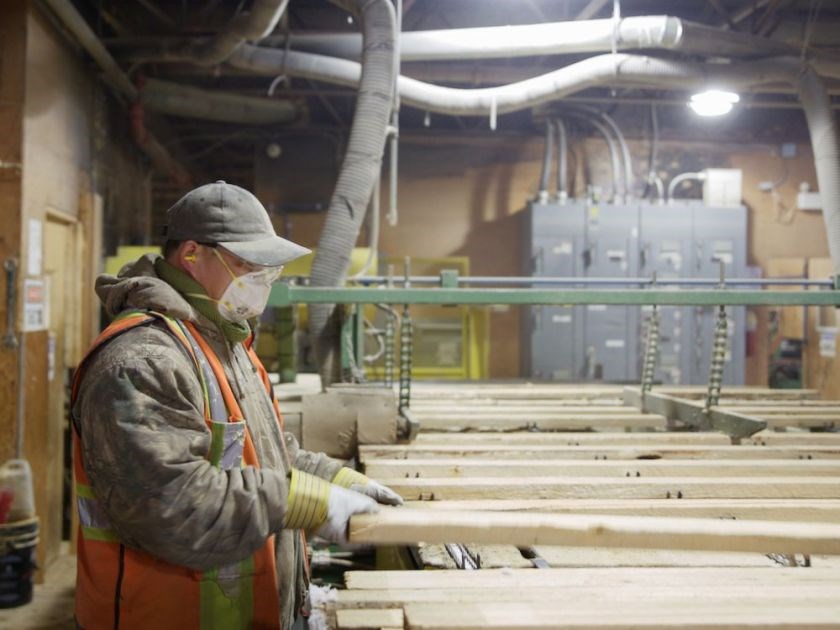QUESNEL - On the industrial outskirts of town, C&C Wood Products kept running its operations through a cruel summer of layoffs, production curtailments and mill closures in British Columbia’s forest industry.
It wasn’t easy, said C&C plant manager Tim Potter. Staying in operation meant keeping a careful eye on staffing to make sure they ran as efficiently as possible.
“Yes, the purse strings were a bit tighter, but the giants, you know, they stumbled a bit,” Potter said, “and we just kept on running.”
And while rival forestry giant Tolko Industries permanently closed its Quest Mill in Quesnel, C&C embarked on an expansion with construction of a new value-added plant in Cranbrook.
“There aren’t many companies out there that are pursuing a close to $10 million project in starting up another wood processing facility in this province right now,” Potter said, “But we are. I think that says something for what we do and how we do it.”
C&C kept running, with a full crew of 150 doing what the company has done since 1975, taking the scraps of timber the primary sawmilling-sector doesn’t want - undersized tree tops, pine-beetle salvage logs, aspen hardwood, and turning it into specialty wall panelling, mouldings and trim.
And C&C is an example of what the City of Quesnel is looking for more of as the primary lumber manufacturing side of the industry keeps contracting in the face of shrinking timber supplies forcing communities across the province into a moment of reinvention.
Towns such as Fort St. James and Clearwater have been forced into a more sudden contemplation of their futures with the permanent loss of mills.
Quesnel has had a bit more foresight and, in a way, is an example for other locations.
“(C&C) are extremely innovative,” said Erin Robinson, manager of forestry initiatives in the city-spearheaded Forestry Innovation Centre, taking undersized timber and aspen to make products out of “things we used to traditionally just put in a pile and waste.”
“So C&C is quite nimble, adaptive,” Robinson said, and an enthusiastic participant in the transition planning that Quesnel embarked on in 2015 after former Cariboo MLA and forestry consultant Bob Simpson took over as Mayor of Quesnel.
Quesnel’s initiatives involved hiring Robinson and another coordinator, launching a community wildfire protection plan to map danger zones in forests surrounding the town, spark a discussion with the province and First Nations about how to rehabilitate the wider timber supply area and develop an analysis and business case for diversifying B.C.’s lumber-manufacturing sector.
Simpson said it became evident near the start of the mountain pine beetle infestation, which wound up chewing through an area of lodgepole pine forests almost four-and-a-half times the size of Switzerland, that the industry would run into a problem.
“It didn’t take a rocket scientist to do some, basic forecasting to see, OK, we’ve got an (allowable harvest), that is going to just crash and burn and we have too many mills,” Simpson said.
Quesnel lost one sawmill in 2014 when Canfor Corp. closed its facility there in a swap of timber rights with its rival, the Quesnel-headquartered West Fraser Timber Co. Ltd.
“Most communities in that kind of a situation would choose an economic development strategy that would transition you away from the sector,” Simpson said, but “we think we still are really well positioned to reinvent the forest sector (that other communities) are walking away from.”
For C&C, Quesnel’s efforts are a welcome step as it contemplates some of its own potential problems that will affect its future survival.
“It’s a great opportunity to collaborate,” said Taiho Krahn, C&C’s manager for its fibre supply and relationships with stakeholders. “(It) forces us to come together to work together as a community.”
One of C&C’s concerns is that it depends on a license to log mountain-pine-beetle-killed pine trees for much of its timber supply, that runs out in 2027. Where all other producers assumed such dead pine trees would be unusable five years ago, C&C is still making value-added products out of it, but “Can we go another seven years, for the length of our license? We don’t know that,” Krahn said.
However, Quesnel’s work on wildfire protection, with the thinning and brush clearing work that goes with it, offers opportunities to access sources of timber, so does the prospect of a community forest license that has just been granted to Quesnel.
“We jumped at the opportunity to participate in the fire-fuel mitigation projects,” Krahn said, with C&C instrumental in securing a $1 million grant from provincial sources for land-treatment projects, which the company gifted to the city.
Krahn is also looking forward to efforts to better manage Quesnel’s timber supply area as a pilot project, which has companies, the Ministry of Forests and First Nations “willing to work together and engage together to survive and hopefully thrive.”
“Nobody said it was going to be easy though,” Potter added.



